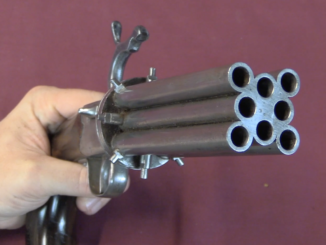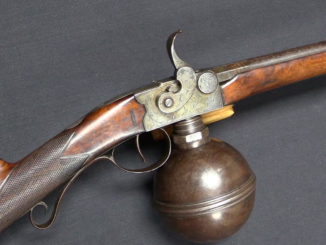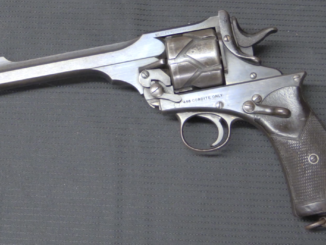The Prideaux speed loader was one of several early such devices patented and manufactured as early as 1893, but neither it nor any competitor saw much demand until the outbreak of World War One. At that point, a substantial number were purchased privately by individual officers for use in the trenches – enough that they came to the attention of the British military administration. In October of 1918 the Prideaux specifically was formally adopted by the British military, although none were procured until after the war ended – all surviving military examples show 1919 dates.
Related Articles

Revolver
Oversized 8-Barrel British Pepperbox Revolver
The typical pepperbox revolver is a sleek and small .31 caliber double action pocket gun, like the Allen & Thurber standard type. This one, however, is anything but typical. This London-made gun is a far […]

Air gun
Pritchard’s 19th Century Precharged Air Gun
William Pritchard was a Birmingham gunsmith in the mid 1800s who offered both firearms and air guns, and this particular ball-reservoir air gun is a fine example of the latter. Air guns have existed in […]

Revolver
Major Fosbery’s Automatic Revolver: History and Mechanics
George Fosbery, V.C., was a decorated British officer with substantial combat experience in India when he decided to design a better sidearm in 1895. True semiautomatic handguns were in their very early stages of development […]

The little ring on the end facilitated hanging the loaders around one’s neck, not unlike the lanyard loop that kept you hooked to your handgun. There are illustrations floating about of officers on trench raids wearing two or three reloads hanging down their chests. Nowhere on the web is their video of the Prideaux itself being reloaded. Too late to rectify this?
I am told the .38 Prideaux for the Mark IV Webley will happily reload modern S&W K-frame revolvers. There might be a market for those fakes, they wouldn’t even have to be rendered as fakes.
edit: nowhere is there video, not their. No spellcheck in the morning. Their chests is correct. Sorry, I did mess up.
It would be interesting to know a little more about the history of speedloaders in general. I have seen drawings, but not a photo, of a 2-piece wood-core speedloader with a separate metal ring to hold the rounds that was apparently intended for use with the 1892 Colt.
I think you have searched Carl J. Ehbets’s “cartridge feed pack for revolvers” (US patent 402,424, patented Apr. 30, 1889.). Here your are: [https://patentimages.storage.googleapis.com/24/24/16/f87e368d893fa2/US402424.pdf]. A photo can be found here: [http://www.mcpheetersantiquemilitaria.com/09_guns_parts/09_item_038.htm].
I’m always fascinated by cool devices from the time before plastics.
“(…)cool devices from the time before plastics.”
If you are interested in advertisement of above described Prideaux Speedloader see 1st image from top: https://laststandonzombieisland.com/tag/lcr-speedloader/
otherwise ignore this post entirely
Note that interestingly this device was called Magazine back then, which might be confused for modern reader.
Assuming that a magazine was merely a container for reserved ammunition, calling a speed-loader a magazine made sense in the old days. I could be wrong.
I could watch Ian load a Webley-Fosbery w/ this speedloader all day.
So it will work with a Webly in .45 Auto Rim/?ACP conversion?
I gotta wonder if the speedloaders were issued out in WW2….or were they surplussed when the UK went to the 38-200 from the 455
I think you might be interested in:
Nigel Uttig: Prideaux’s Improved Patent Magazine Loader for Rapidly Loading Revolvers
https://web.archive.org/web/20191019063411/http://utting.org/writing/nvtu/shooting/prideaux-loader.pdf
William de Courcy Prideaux was my great uncle. He also developed and patented a non-jamming machine gun belt. The Imperial War Museum in London holds a number of his papers. He was a dentist by profession, living in Dorset UK, but also heavily involved in archeology. One of his brothers was curator of the Dorset County Museum, the other, my grandfather, was a superb shot and won a lot of prizes for shooting.